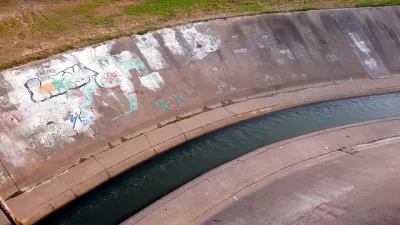Adam Krantz, who leads the National Association of Clean Water Agencies, breaks down how the Trump Administration infrastructure plan would impact local water infrastructure.

After an in-depth review of the administration's proposed infrastructure finance plan, National Association of Clean Water Agencies CEO Adam Krantz concludes: "Ultimately, this is not going to save municipalities money. It’s going to require municipalities to raise more money—more capital and more investment dollars—to do large new projects."
In The Planning Report, Krantz highlights the positives the plan offers for the water sector. For one, it makes water a clearly defined priority in national infrastructure—"something we haven't seen before."
For another, it encourages collaboration and innovation: "The administration's overlay of innovation is a good thing, and should stay part of any bill."
But core elements of the proposal are troubling to the water agencies represented by NACWA: the additional burden on municipalities to raise capital, the limited amount of funding available, and the emphasis on beginning bold new projects rather than meeting existing infrastructure needs. What municipalities need instead, Krantz argues, is more direct federal spending—a goal he hopes can be achieved in Congress by marrying the administration's push for private partnerships with the funding model proposed by alternative bills.
Krantz's full analysis can be found in The Planning Report.
FULL STORY: White House’s “Jump Ball” Infrastructure Financing Plan: Unpacking Its Impact on Water Projects

Study: Maui’s Plan to Convert Vacation Rentals to Long-Term Housing Could Cause Nearly $1 Billion Economic Loss
The plan would reduce visitor accommodation by 25,% resulting in 1,900 jobs lost.

Alabama: Trump Terminates Settlements for Black Communities Harmed By Raw Sewage
Trump deemed the landmark civil rights agreement “illegal DEI and environmental justice policy.”

North Texas Transit Leaders Tout Benefits of TOD for Growing Region
At a summit focused on transit-oriented development, policymakers discussed how North Texas’ expanded light rail system can serve as a tool for economic growth.

San Diego County Sees a Rise in Urban Coyotes
San Diego County experiences a rise in urban coyotes, as sightings become prevalent throughout its urban neighbourhoods and surrounding areas.

Los Angeles County Invests in Wildfire Recovery for Parks, Trails, and Open Space
The $4.25 million RESTORE Program supports the recovery of parks, trails, and open spaces damaged by the January 2025 wildfires through targeted grants that promote community healing, wildfire resilience, and equitable access to nature.

Nevada Bills Aim to Establish Home Insurance Assurance Amidst Wildfire Risk
Republican sponsor hopes the FAIR plan would be “a true market of last resort.”
Urban Design for Planners 1: Software Tools
This six-course series explores essential urban design concepts using open source software and equips planners with the tools they need to participate fully in the urban design process.
Planning for Universal Design
Learn the tools for implementing Universal Design in planning regulations.
Smith Gee Studio
Alamo Area Metropolitan Planning Organization
City of Santa Clarita
Institute for Housing and Urban Development Studies (IHS)
City of Grandview
Harvard GSD Executive Education
Toledo-Lucas County Plan Commissions
Salt Lake City
NYU Wagner Graduate School of Public Service





























